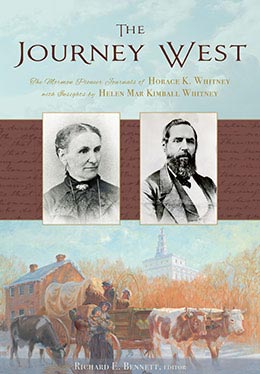Acknowledgments
This editorial project is an “IOU” of sorts that I have been intending to complete for a long time. I made up my mind over thirty-five years ago that someday I would edit and publish the Horace K. Whitney journals. I was convinced that this unpublished resource that had proven to be of such great value to me surely would benefit others. Despite my best intentions, however, life’s interruptions, six other books, and over sixty articles got in the way. However, with the help and support of many people and an excellent publisher in the Religious Studies Center of Brigham Young University, that day has finally come!
I first became aware of the significance of the Whitney journals when working as a research assistant for Leonard J. Arrington, who had been recently appointed as church historian. I will ever look back upon this remarkable scholar, friend, and mentor as one of the richest blessings of my professional life. His love for Mormon history and for those engaged in researching and writing it was contagiously inspiring and so very encouraging. Likewise, I will ever owe a debt of gratitude to Marvin S. Hill, who taught me how to utilize primary source documents in evidential ways. Later, while a PhD student at Wayne State University, I was once again tutored by one of the finest gentleman-scholars in the land—Professor Philip Mason, director of the Walter P. Reuther Library of Labor and Urban Affairs. With his encouragement, I wrote my dissertation on the Mormon exodus and, in the process, came to understand and appreciate the professional world of archival science and the power of the manuscript.
After completing my course work at Wayne State University, I spent the next twenty years in Winnipeg at the University of Manitoba as head of the Department of Archives and Special Collections. While sundry career priorities inevitably got in the way, I never lost interest in the Whitney project. I want to thank my library directors through those years, who encouraged me to work on this labor of love as time permitted. With their encouragement and support, I received funding from the Social Sciences and Research Council of Canada to continue work on this project. Later, after joining the faculty at Brigham Young University in 1997, I continued to receive institutional support in the form of small research grants and occasional time off to continue in this work. Finally, a generous grant from the Frederick W. and Jolene Edmunds Rockwood Family Foundation greatly facilitated the hiring of student editorial support staff and has expedited the tedious work of carefully editing, proofreading, and digitizing these journals. Without the foundation’s financial assistance, this project would still be years from completion.
I also need to thank the Horace K. Whitney family for preserving and donating the Whitney journals in the first place to The Church History Library of the Church of Jesus Christ of Latter-day Saints so many years ago. Long after their donation, Edyth Jenkins Romney, longtime editorial assistant and secretary to what was then called the Church Historian’s Office, spent months making a remarkably accurate initial transcription of these ofttimes very hard to read journals, a wonderful time-saving transcription which has proven very valuable to the present project. Of course, I appreciate the Church History Library for permission to edit and publish these journals after these many years. I wish also to thank the staff at the LDS Church History Library, the Church History Museum of The Church of Jesus Christ of Latter-day Saints, the L. Tom Perry Special Collections in the Harold B. Lee Library at Brigham Young University, Special Collections and Archives at the Merrill-Cazier Library at Utah State University, the Utah State Historical Society, and the Wyoming State Archives for their invaluable assistance.
Many student research assistants have also assisted me through the years on this project, some whose names I have forgotten. My thanks especially to the following: Hugh Hannesson, who was me with me at the very beginning; Natalie Larson, who spent the better part of a year proofreading the text and typing the original typescript copy on the computer; Wendy Top, my current research assistant, who has been particularly helpful in ensuring the quality of the glossary of names; and Brittany Armstrong and Katie Cook, two of my current teaching assistants. Finally, I owe a special, more recent debt of gratitude to the editorial staff of the Religious Studies Center at Brigham Young University. These include Thomas A. Wayment, publications director, who agreed to take on this project; Joany O. Pinegar, publications supervisor; editors Devan Jensen, Tyler Balli, and Megan Judd; designer Emily Strong; and Brent Nordgren, production supervisor.
Above all, I thank my wife, Patricia, who once again has put up with the other love of my life—writing and editing works of church history. She has been a wonderfully patient, uncomplaining partner, going where I have gone, listening, encouraging, and ever supporting.
